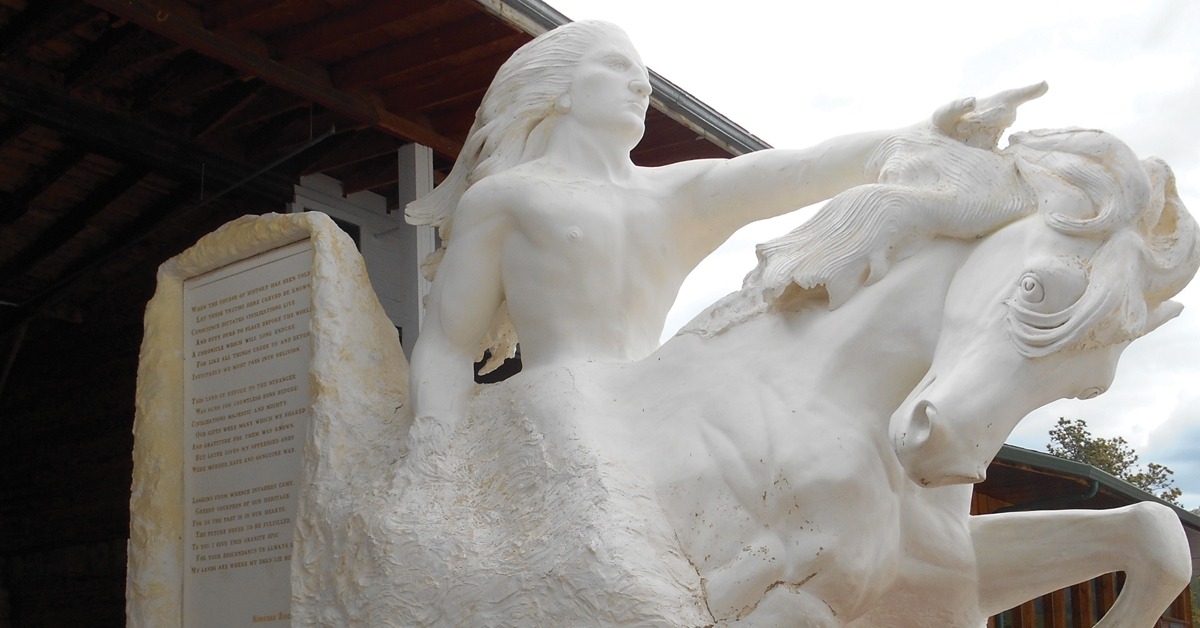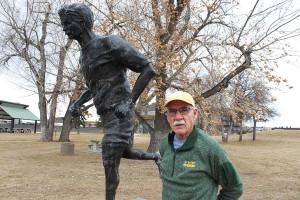A gigantic sculpture of Lakota Chief Crazy Horse riding his pony gradually emerges from the mountain in the southwest corner of South Dakota, about 25 miles southwest of Rapid City near Custer. Continuously under construction since 1947, the sculpture is far from complete.
Watching the blasting that shapes the epic carving is worth the trip from Idaho or Montana, and visiting the associated Indian Museum of America is a bonus.
Crazy Horse (ca. 1842-1877) was a war leader of the Oglala Lakota. He fought in the Battle of the Little Bighorn, afterward continuing to defy U. S. government encroachment on Indian lands.
Shot by a prison guard in Nebraska while resisting arrest, he refused to lie in a white man’s cot. He died on the jail floor.
Changing Attitudes
But attitudes change. In 1982 the United States Postal Service honored him with a commemorative stamp.
The completed face of Crazy Horse (87 feet 3 inches) is much larger than Mount Rushmore’s faces that tower at 60 feet. His arm extends 263 feet with a 29-½-inch pointing finger. What will be the horse’s head will stand 22 stories high, with 20-foot eyes and flaring nostrils 26 feet in diameter.
The Crazy Horse Memorial was inspired by Oglala Lakota Chief [Henry] Standing Bear and conceived by Korzac Ziolkowski (say Jul-COW-ski.) Disturbed that American heroes were being sculpted on Indian land, Chief Standing Bear’s brother Luther, also a chief, in 1931 petitioned Idaho-born sculptor Gutzon Borglum to include Crazy Horse beside Lincoln and Washington on Mt. Rushmore. Borglum did not respond. Korzac was assisting Borglum sculpting Mt. Rushmore in 1939 when Chief Standing Bear wrote him a letter saying, “Indian people have heroes, too.”
Korzak did respond.
Building A Monument
In 1940 Korzak met for three weeks with Standing Bear and other Indian chiefs. Impressed with them and their cause, he promised he would carve a monument for the Indian people equally as impressive as Mt. Rushmore.
He preferred to carve the Crazy Horse Monument in the high-quality granite near the Tetons, something Idahoans would have liked, but the Lakota insisted that their monument stand on their own land.
A self-taught sculptor, Korzac Ziolkowski was born in 1908 in Boston, Mass., of Polish immigrant parents and orphaned at age one. Life in foster homes made getting an education difficult, but he managed to earn his way through a technical school. This prepared him for work as a ship carpenter’s apprentice and later as a furniture maker.
After beginning to carve in wood, he completed his first marble sculpture in 1932 to honor a judge who had been helpful to him. From that time forward, he sculpted many commissions and won first prize at the 1939 New York World’s Fair for his sculpture of the famous pianist Padarewski.
Service in World War II delayed Korzak’s beginning the Crazy Horse sculpture. Wounded at Omaha Beach, he was 40 when he returned to the project. He continued work on the sculpture until his death. Today, his children and many of his grandchildren work together to complete this humongous work of art.
Korzac met Ruth Ross, an art enthusiast, while researching for the Crazy Horse project. They married and established their family, eventually 5 boys and 5 girls, at the monument site. Korzac delivered one of the children when a fierce snow storm prevented him from driving Ruth to the hospital. In their remote location, they needed to be almost completely independent, so the Crazy Horse site has included a dairy farm, lumber mill, various other enterprises, and a one-room school with a certified teacher.
As the children grew, the boys were trained in sculpture and worked alongside their father while the girls assisted their mother in the visitors complex. It grew into the extensive Indian Museum of North America.
Korzac died in 1982, and Ruth lived until 2006. They are buried at the base of the mountain.
Continuing Work on the Monument
Each section of the sculpting begins with careful calculations and preparations before drilling for a “production blast” to reduce a 20-foot rock face down to 6 or 8 feet. Smaller blasts follow. Each section is completed with intricate rock removal by hand. Work follows Korzac’s detailed design for the Crazy Horse sculpture.
A beautiful statue in its own right, Korzac’s marble model for the monument stands outside the picture window of the museum. Work on the monument can be observed from that window, too. The horse’s mane seems alive with the motion of horse and wind.
Inside, a nearby bin holds rocks for sale, samples from the millions of tons that have been blasted away. Tourmaline, feldspar, quartz, mica, pyrite, iron, and even the semi-precious gems garnet and beryl make up the metamorphic rock known as granite, of which this mountain is composed. The many different compressed minerals give granite its variety of colors.
The Museum
In the museum a continuously running video shown explains the project and helps visitors plan the best use of their time while at the site. Tours allow visitors close access to the evolving sculpture.
The museum contains extensive displays of Native American art—photographs, weaving, household items, and cultural artifacts from many tribes. The room representing the home of the Ziolkowskis illustrates the richness of their lives. It includes some of Korzac’s sculptures, among them the carousel-style rocking horse his children rode as well as his self-sculpture, which is displayed with his WWII medals.
Surrounding Areas
There is plenty more to see nearby: Mt. Rushmore, Wind Cave National Park, and the Badlands. The easiest route to the area from Idaho or Montana is via I-90 to Rapid City, but slower routes offer many interesting sights along the way.
Beyond Yellowstone National Park or Jackson, Wyoming lie The Buffalo Bill Center of the West in Cody, Heart Mountain Japanese Internment Memorial near Powell, and Devil’s Tower. US-30 passes close to Sacajawea’s grave near Fort Washakie and a fine frontier museum in Lander. Many historical Oregon Trail sites lie close to I-80.
Except for the detour to Devil’s Tower, which passes through Spearfish, S. D., all these routes lead via US-16 to Custer, the town closest to the Crazy Horse Memorial. Accommodations are available there or in Rapid City. MSN











